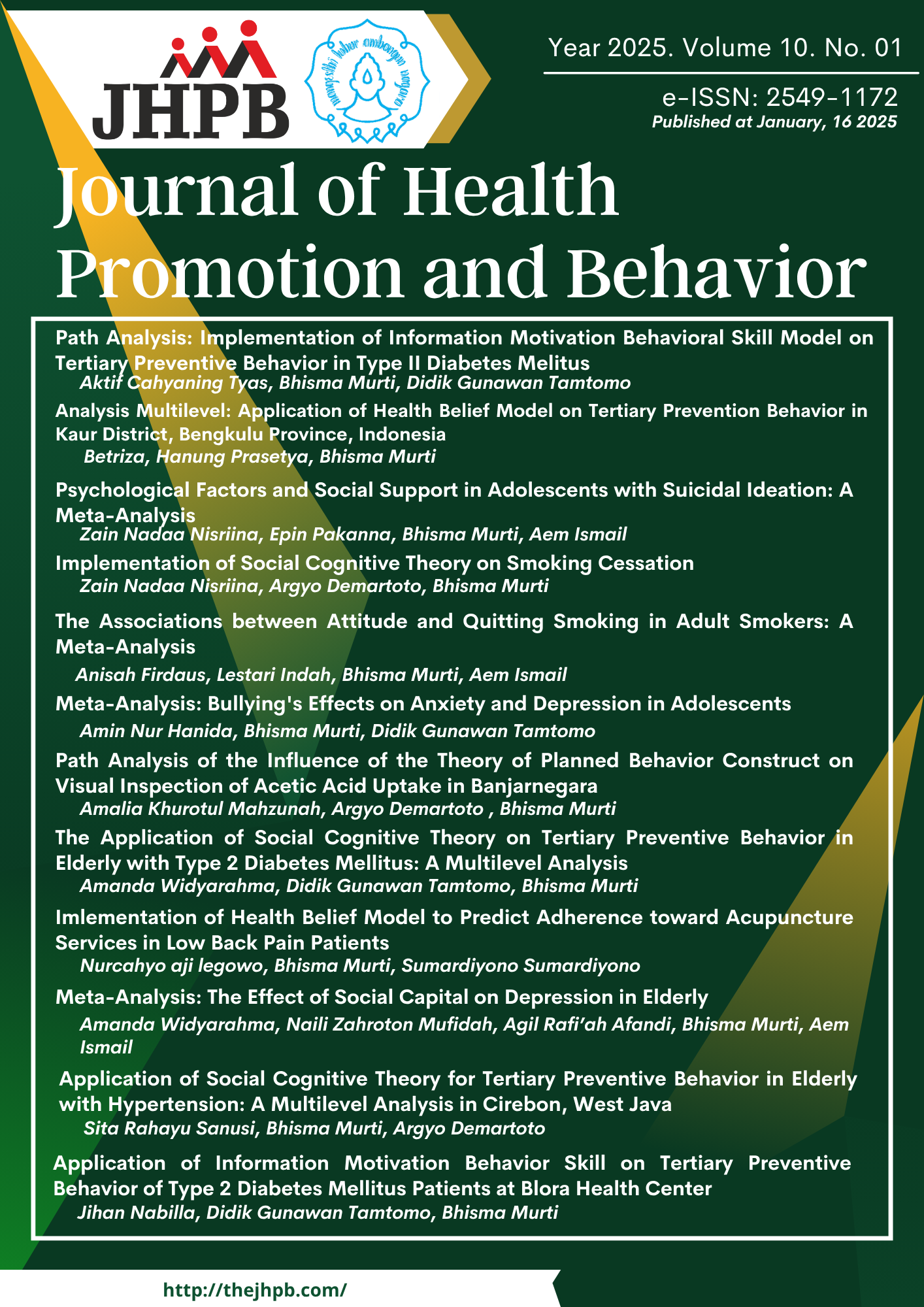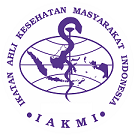Application of Social Cognitive Theory for Tertiary Preventive Behavior in Elderly with Hypertension: A Multilevel Analysis in Cirebon, West Java
DOI:
https://doi.org/10.26911/thejhpb.2025.10.01.11Abstract
Background: Hypertension is the first non-communicable disease diagnosed in various health facilities up to 185,857 cases. Hypertension is one of the main causes of mortality and morbidity in Indonesia, so the management of this disease is a very common intervention carried out at various levels of health facilities, especially in the elderly. This study aims to analyze the influence of the application of social cognitive theory on the preventive behavior of the elderly tertiary with hypertension in Cirebon Regency.
Subjects and Method: The study was conducted with a cross-sectional study design involving as many as 200 research subjects, including 102 positive tertiary preventive behavior research subjects and 93 negative tertiary preventive behavior research subjects. This research was conducted in 25 elderly posyandu in Cirebon Regency, West Java. This research was conducted in March-April 2024. The sample was selected using simple random sampling to select elderly research subjects with hypertension and stratified random sampling to select the type of Posyandu. The dependent variable is tertiary preventive behavior behavior in the elderly with hypertension. The independent variables were knowledge, expectations, self-regulation, self-efficacy, reinforcement and observational learning. Data collection was carried out using questionnaires and data were analyzed using a multilevel analysis model..
Results: Tertiary preventive behavior in older age with hypertension was influenced by knowledge (b = 1.89; 95% CI = 1.54 to 2.23; p <0.001), expectations (b = 0.15; 95% CI = 0.01 to 0.29; p = 0.031), self-regulation (b = 0.15; 95% CI = 0.01 to 0.29; p = 0.035), self-efficacy (b = 0.14; 95% CI = 0.00 to 0.29; p = 0.042), reinforcement (b = 0.15; 95% CI = 0.00 to 0.29; p = 0.042), reinforcement (b = 0.36; 95% CI = 0.22 to 0.50; p <0.001), and observational (b = 0.22; 95% CI = 0.07 to 0.38; p = 0.004). Posyandu has a contextual influence on tertiary preventive behavior in the elderly with hypertension with ICC = 40%.
Conclusion: Tertiary preventive behavior in the elderly with hypertension is influenced by knowledge, expectations, self-regulation, self-efficacy, reinforcement and positive outcomes of observational learning. Thus, social cognitive theory can be used to explain and predict tertiary preventive behavior in the elderly with hypertension. Variations at the Posyandu level have a strong contextual effect on tertiary preventive behavior in the elderly with hypertension.
Keywords:
hypertension, social cognitive theory, old age, tertiary preventive behaviorHow to Cite
References
AHA (american Heart Association). (2017). Hypertension: The Silent Killer: Updated JNC-8 Guideline Recom-mendations. Alabama Pharmacy Association. https://doi.org/0178-00-00-15-104-H01-P
Angeli JM, Harpster K, Huijs L, Seid M, Sheehan A, Schwab SM (2019). Pati-ent-centered goal setting in develop-mental therapy: discordance between documented goals and caregiver-perceived goals. Pediatr qual Saf. 4(4); 199. doi.org/10.1097/pq9.000-0000000000199.
Bustang A, Zaenal S, Irmayani (2020). Hubungan gaya hidup dengan kejadi-an hipertensi di Puskesmas Sabutung Kabupaten Pangkep. JKD. https:-//jurnal.stikesnh.ac.id/index.php/jikd/357.
Carey RM, Wright JT, Taler SJ (2021). Guideline driven management of hypertension. Circ Res. 128: 827-846. https://doi.org/10.1161.
Chian LC, Wei CH, Yao-Tei T, Shao-Jen W, Ho-Pang Y, Shih-Chia L (2020). Healthy life expectancies by the effects of hypertension and diabetes for the middle aged and over in Taiwan. Int J Environ Res Public Health. 17: 4390. doi:10.3390/ijerph-17124390.
Dinas Kesehatan Kabupaten Cirebon (2020). Profil kesehatan kabupaten Cirebon,
DKIS Cirebon. (2021). Angka prevalensi hipertensi. Dinas Komunikasi Infor-matika dan StatistikKota Cirebon. https://dkis.cirebonkota.go.id/2021/02/angkaprevalensihipertensi
Ghoreishi MS, Vahedian SM, Jafari A, Tehranid H (2019). Selfcare behaviors in patients with type 2 diabetes: Education intervention base on social cognitive theory. Diabetes Metab Syndr. 13(3): 2049–2056. doi.org/-10.1016/j.dsx.2019.04.045
Pakseresht M, Mead E, Gittelsohn J, Roache C, Sharma S (2010). Awarness of chronic disease diagnosis amongst family members is associated with healthy dietary knowledge but not behaviour amongst inuit in Arctic Canada. J Hum Nutr Diet. 1: 100. https://doi.org/10.1111/j.1365-277x.2-010.01101.x.
Herlinah L (2013). Hubungan dukungan keluarga dengan perilaku lansia dalam pengendalian hipertensi (The relationship between family support and elderly behavior in hypertension control). JKK. 1(2); 108-115.
Huda S (2015). Factor associated with self-care management among adult people with hypertension in Jepara Java Indonesian. Anpor Annual Conference. https://www.researchgate.net/pu-blication/301231982.
Irani N (2019). Hubungan dukungan kelu-arga dan kader dengan perilaku lansia hipertensi dalam mengendalikan kesehatan di Puskesmas Mranggen (The relationship between family and cadre support and the behavior of the hypertensive elderly in controlling health at the Mranggen Health Center). Jurnal Keperawatan.1(1);7-13. https://jurnal.unimus.ac.id/index.-php/JKK/article/view/987/1036
Potter P, Perry AG (2015). Buku ajar funda-mental keperawatan: konsep, proses dan praktik (2nd ed) (Textbook of Fundamentals of Nursing: Concepts, Processes and Practice (2nd ed)). EGC. Jakarta.
Kristina K, Ainun K, Leini S. (2021). Terapi Foot Massage Untuk Menurunkan Dan Menstabilkan Tekanan Darah Pada Penderita Hipertensi. Abdimas Galuh (Foot massage therapy to lower and stabilize blood pressure in hyper-tensive patients. Abdimas Galuh), 3(2): 328. https://doi.org/10-.25157/ag.v3i2.5902.
Lewis, Shannon Ruff Dirksen, Margaret McLean Heitkemper, Linda Bucher. (2014). Medical surgical nursing: Assessment and management of clinical problems. St. Louis, Missouri: Elsevier Mosby.
Maharani R (2016). Faktor-faktor yang ber-hubungan dengan perilaku pengen-dalian tekanan darah pada penderita hipertensi di Puskesmas Harapan Raya Kota Pekanbaru (Factors related to blood pressure control behavior in hypertensive patients at the Harapan Raya Health Center in Pekanbaru City). Jurnal Kesehatan Komunitas. 3(5): 165-171. http://jurnal.htp.ac.id/-index.php/keskom/article/view/122
Manurung N (2018). Keperawatan Medikal Bedah Konsep, Mind Mapping dan Nanda NIC NOC. Jakarta Timur: CV. Trans Info Media.
Morse BAB (2017). The role of observatio-nal learning in developing ecotourists’ environmentally responsible behavio-ral intentions. Master of Science. Uni-versity of Michigan. Retrieved from https://deepblue.lib.umich.edu/bit-stream/handle/2027.42/136232/Morse_Benjamin_Thesis.pdf?sequence=1&isAl-lowed=y.
Saraswati D (2018). Determinan pengeta-huan dan dukungan sosial keluarga dengan perilaku pengendalian hiper-tensi di Puskesmas Karangnunggal Kabupaten Tasikmalaya. J Health Sci Med Res. 2(2): 283-296. http://-ejurnal.ung.ac.id/index.php/gojhes/article/view/5272/1867.
Setyaningsih R (2013). Pengaruh motivasi, dukungan keluarga dan peran kader kesehatan terhadap perilaku pengen-dalian hipertensi. Indonesia Journal on Medical Science. 6(1): 79-85. https://ejournal.ijmsbm.org/index.php/ijm s/article/view/173/173
Shamizadeh T, Jahangiry L, Sarbakhsh P, Ponnet K (2019). Social cognitive theory-based intervention to promote physical activity among prediabetic rural people: A cluster randomized controlled trial. Trials. 20(1): 98. https://doi.org/10.1186/s13063-019-3220-z.
Smeltzer, Bare (2013). Textbook of medical surgical nursing. Jakarta: EGC.
Soejati SZ (2015). Konsep sehat sakit dan penyakit dalam konteks sosial budaya (The concept of healthy sickness and disease in a socio-cultural context). Jakarta: Depkes RI.
Sumadi (2008). Hubungan antara tingkat pengetahuan lansia tentang hipertensi dengan upaya mengendalikan hipertensi di posyandu lansia Puskesmas Semin 1 Gunung Kidul Yogyakarta (The relationship between the elderly's level of knowledge about hypertension and efforts to control hypertension at the Semin 1 Elderly health post, Gunung Kidul Yogyakarta). http://digilib.unnes.
Tirtasari. S, Kodim N. (2019). Prevalensi dan Karakteristik Hipertensi Pada Usia Dewasa Muda di Indonesia (Prevalence and Characteristics of Hypertension in Young Adults in Indonesia.). Tarumanagara Medical Journal, 1(2), 395– 402
Tobias BC, Mardijanto (2017). Hubungan pengetahuan tentang hipertensi dengan perilaku lansia dalam pen-cegahan hipertensi di posyandu lansia Desa Tegal Wangi Kecamatan Umbul-sari Kabupaten Jember (The relation-ship between knowledge about hyper-tension and elderly behavior in hyper-tension prevention at the Elderly Posyandu Tegal Wangi Village, Umbulsari District, Jember Regency). 3(2):143–54.
Uhlig K, Patel K, Ip S, Kitsios GD, Balk EM (2013). Self-measured blood pressure monitoring in the management of hypertension: a systematic review and meta-analysis. Ann Magang Med. 159(3): 185–194. https://doi.org/10.-7326/0003-4819-159-3-201308060-00008.
WHO. (2019). Global strategy on diet, physical activity and health. Geneva: World Health Organization





